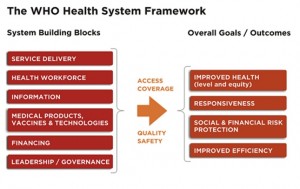A really equitable health system is that that ensures that people with special needs also have fair access to healthcare. This is especially relevant for people with communication needs, who may experience more barriers of access to healthcare services.
Inclusive communication is an approach to communication in which information and its understanding are made accessible to everyone

By Alex Henriquez
Research Analyst at Healthcare Improvement Scotland / Scottish Health Council
Inclusive Communication as a Mechanism to Improve Equity of Access in Health Systems
Equity in Health Systems means that everyone should receive a fair treatment independently of their economic or physical conditions. It is very easy to link equity in health systems with fair access of those of us who do not have either a physical or learning disability. However, a really equitable health system is that that ensures that people with special needs also have fair access to healthcare. This is especially relevant for people with communication needs, who may experience more barriers of access to healthcare services. Here is where the approach of inclusive communication represents a powerful tool for health systems and global health practitioners to ensure that those who experience more barriers of access to healthcare, can receive the attention they need.
Inclusive communication is an approach to communication in which information and its understanding are made accessible to everyone (Mander, 2015). To make information accessible to every person it is necessary to recognise that people have different levels of understanding and specific communication support needs that must be taken into consideration (Hartley Kean, 2016). This includes people with a learning disability, autistic spectrum disorders, dementia, neurological illness, stroke, cancer, head or brain injury, visual impairment, people who are deaf or blind or who have a dual sensory impairment, as well as those who have aphasia, autism, motor neurone, cerebral palsy and mental illness (Scottish_Government, 2015).
Research suggests that people with learning and physical disabilities face serious health inequalities compared to the rest of the population. For instance, they are three times as likely to die early than the general population (Turner and Robinson, 2010). Moreover, their prospects to experience poor general health or to have high levels of unmet physical and mental health needs are greater than the rest of the population (Turner and Robinson, 2010).
Some of the key determinants of these inequalities include exposure to social determinants of ill health such as poor housing, unemployment, poverty and disconnectedness (Emerson and Baines, 2010). However, and in addition to these, communication difficulties and poor health literacy are also considered a key determinant, one that can be challenged by health services providers (Turner and Robinson, 2010).
Within the healthcare system, the provision of accessible information is regarded as a key component of quality healthcare and the promotion of wellbeing (Jarrett et al., 2015). Therefore, serious investment in producing resources that meet people’s communication needs; training and supporting staff; and fashioning the delivery of health services to enable people with disabilities to make informed choices are regarded as essential to ensure they experience fair services and enjoy a better health (Jarrett et al., 2015).
In the 21st century it is important for healthcare practitioners to consider that people with special communication needs can improve their access to healthcare, if the communication barriers they experience are tackled wholly from a those systems approach in which accessible information is constantly promoted.
Evidence on Inclusive Communication
The availability of primary research into inclusive communication practice and its impact on people with communication support needs is limited. Existing research into inclusive communication can be organised into three main categories; first, studies that focus on communication resources, second, studies that focus on the implementation of specific resources among a specific social sub-group; third, studies that analyse the processes involved in the delivery of inclusive communication materials.
Within the first category, two studies have been reviewed (Shiose et al., 2009, Geiger, 2010). These concluded that the use of inclusive resources and the inclusion of people with disabilities in the design and implementation of information resources help to promote awareness and social participation. Shiose et al. (2009) investigated the effects of inclusive communication as a mean to raise awareness of people’s different communication needs. They found that the implementation of inclusive communication resources and the inclusion of elderly and disabled people in the design process of educational materials can help to improve social awareness. Likewise, Geiger (2010) highlights the efficacy of culturally specific non-verbal communication and contextual elements as a mean to enable the communicative participation of young children with severe disabilities.
Within the second category, Jones et al. (2007) investigated the impact of using a picture book about cancer to meet the information needs of cancer patients with learning disabilities. They found that while the resource allowed patients to receive cancer information, there were knowledge and information gaps between doctors, learning disability staff and carers that prevented patients from having a deeper understanding about their condition and treatment options (Jones et al., 2007). Similarly, Calculator (2009) analysed the role of Augmentative and Alternative Communication (AAC) as a mean to successfully promote the inclusion of students with severe disabilities in general education. He concluded by stating that integration of AAC can be used as a tool to promote everyone’s access to information and participation and not only those in need of it. However, he highlights that the sole existence of AAC and other forms of inclusive technology will not guarantee inclusion and participation unless there are clear processes and practices in which teachers, learning disabilities staff and all students engage in order to consider the communication support needs of those with learning disabilities (Calculator, 2009). If these processes are not taken into account, people with communication support needs will continue facing barriers to access information and services despite the existence of inclusive information resources and technology (Calculator, 2009).
Within the third category, Mander (2015) investigated the experience of accessible information between the British National Health Service staff and service users with learning disabilities. She found that while the practice of producing accessible resources has become more widespread and advanced, the same cannot be said about the practice of delivering them, which varies across service providers (Mander, 2015). Whilst she observed a degree of engagement with service users within specialist services, there was limited evidence to suggest cross-service engagement in inclusive communication (Mander, 2015).
In a following study, Mander (2016) investigated the delivery of health-related accessible information for adults with learning disabilities. She found that the delivery of accessible information allowed for personalisation and appeared to support understanding; however, this was mediated by the skills of those delivering it. The author concludes by highlighting the necessity to shift focus away from the resources-research and to focus on the processes to deliver accessible information (Mander, 2016).
Similar conclusions were reached by Jarrett et al. (2015) after assessing the use of accessible information material in the provision of healthcare for people with learning disabilities in the NHS Scottish health board of Ayrshire and Arran. They added that the understanding of inclusive communication varied across services, with staff within the learning disabilities and mental health services showing a significantly greater knowledge on resources and delivery of accessible information than those in Primary Care (Jarrett et al., 2015). Just like Mander (2016), Jarrett et al. (2015) reflect on the importance to move beyond the resources and concentrate on the practice of understanding how people recognise, promote, understand and support the delivery of accessible information (Jarrett et al., 2015).
A successful practice in this case is that of the ‘Stroke Voices’ programme from Chest Heart & Stroke Scotland. This is a fully inclusive communication and public involvement training and support resource for people who experience aphasia and cognitive problems after a stroke (Mackellaig et al., 2014). By putting a strong emphasis on public engagement, inclusive training delivery methods and inclusive resource development, the ‘Stroke Voices’ programme has successfully demonstrated that it is possible to support people who have had a stroke to present their views for service development and have a say in their healthcare and treatment options (Mackellaig et al., 2014).
To summarise, research on inclusive communication indicates that the way in which accessible information resources are employed is as important as their availability. Moreover, the effective use of accessible information is determined by the interplay of different factors, such as, a positive attitude of the provider, accurate recognition of service user’s communication needs, the provider’s knowledge of which communication strategy to use, the provider’s skill in using AAC strategies and lastly, the availability of inclusive communication resources ready to match the service user’s communication needs (Hartley Kean, 2016). While existing literature supports the development and use of inclusive communication resources, these are not enough to ensure inclusion and participation. It is necessary to establish clear, effective processes that enable the implementation and delivery of accessible information. The case of ‘Stroke Voices’ shows that it is possible to fully integrate an inclusive communication approach towards the development of stroke services within NHS Scotland.
A considerable property of the delivery of healthcare is the existence of information asymmetries between users and providers which prevent users from accessing the essential information about their health and treatment options, causing costly inefficiencies in the health system (Cruz and Kini, 2012). People with special communication support needs face even greater barriers to access information. As observed by Turner and Robinson (2010) these barriers lead to the widening of health inequalities experienced by them.
While health systems globally strive to improve equity of coverage and access to health services, it is necessary for public health practitioners to make an extra-effort and consider the needs of those with communication support needs. As indicated by the evidence, the availability of accessible informative resources is not enough, it is important to focus on the processes in which information is delivered.
The Scottish Case: Inclusive Communication in Scotland
In 2007 the Scottish Government commissioned a literature review to describe the lived experience of people with communication support needs (Law et al., 2007).The review concluded that in comparison with the general population, people with Communication support needs are more likely to experience negative communication and barriers of access to education, healthcare, criminal justice and other public services (Law et al., 2007). Moreover, they do not receive the necessary information required to utilise services, tend to be misjudged in terms of cognitive and education level, be unemployed and/or employed at low level and live in socially deprived areas (Law et al., 2007). The review concludes by emphasising that service providers must engage with the concept of ‘person centred care’ in order to effectively adapt and respond to the specific communication needs of people with learning and physical disabilities (Law et al., 2007).
Following this, the Scottish Government released in 2010 the Healthcare Quality Strategy which highlights the necessity for services to be person-centred (Scottish_Government, 2010). The Quality Strategy builds on three foundations; people’s views will be gathered and listened in order to improve care; it is about making the right thing for every person, every time and by making continuous measurable improvements in the aspect of quality of care of patients, their families and carers (Scottish_Government, 2011). The strategy also highlights the importance to have clear communication and explanation about conditions and treatments; therefore, for services to be fully person-centred, service providers need to communicate with users in ways that work for them (Scottish_Government, 2011, Hartley Kean, 2016).
In addition to this, between 2010-2014 the Scottish Government commissioned the Communication Forum Scotland to carry out the Civic Participation Network Project for people with communication support needs (Money, 2016). The project lead to the coproduction of the Talk for Scotland Toolkit, which sets out the national principles for inclusive communication. The six principles for inclusive communication will help health and social care services providers to deliver services more effectively and support people with communication support needs. These principles are linked to performance indicators and they operate at national, local and individual level. The principles are as follows:
- Communication accessibility and physical accessibility are equally important
- Every community or group will include people with different communication support needs
- Communication is a two-way process of understanding others and expressing yourself
- Be flexible on the way your service is provided
- Effective user involvement will include the participation of people with different communication support needs
- Keep trying (Scottish_Government, 2011).
While the principles have been valued at national and local level, an examination of their implementation commissioned by the Scottish government, ‘The Joe Report’, indicated that simply having these principles was not enough and that further actions needed be taken in order to properly implement an inclusive communication practice (Money, 2016).
The report indicated that in order to effectively mainstream inclusive communication practice throughout public services it was necessary to have senior staff leading the agenda; to share, evidence-based definitions of quality inclusive communication practice; to make realistic and sustained investment and to have a means of regulating inclusive communication practice (Money, 2016).
Building on these recommendations and on the 2007 United Nations Convention on the Rights for People with Disabilities, in late 2015, the Scottish Government published a consultation on its 2016-20 delivery plan to implement the Convention and realising the vision to become an inclusive communication nation (Scottish_Government, 2015).
In its delivery plan, the Scottish Government wants disabled people to have equal and inclusive access to:
- The physical and cultural environment, transport and suitable, affordable housing
- Healthcare provision and support for independent living. Disabled people will have control over the best use of resources. There will be good quality support for disabled children.
- Education, paid employment and an appropriate income and support whether in or out of work
- The justice system without fear of being unfairly judged or punished, and with protection of personal and private rights.
Lastly, the government emphasises that in order to achieve these outcomes, three ways of working must be adopted by service providers as follows:
- Ensure that disabled people are empowered to participate fully
- Communication is inclusive and is accessible
- The barriers facing disabled people are known, understood and addressed
To Conclude
People with physical and learning disabilities still face barriers of access to health and social care services that contribute to the widening of health inequalities between them and the general population. Inclusive communication represents an opportunity to reduce such barriers and ensure that disabled people not only access the services they need, but also understand their health conditions, treatment options and have a say on these. Evidence indicates that the availability of resources is not enough to achieve this. While resources are important, it is more important to strengthen the processes through which people interact, that is, ensuring that all staff are aware of people’s communication needs, understand them and act upon these. Scotland is on the path to become an inclusive communication nation, while this is a challenging process, it also represents a rich opportunity to move closer towards the goal of achieving equity of access to health services.
References
CALCULATOR, S. N. 2009. Augmentative and alternative communication (AAC) and inclusive education for students with the most severe disabilities. International Journal of Inclusive Education, 13, 93-113.
D’CRUZ, N & KINI, R. 2012. The effect of information assymetry on consumer driven health plans.
EMERSON, E. & BAINES, S. 2010. Health Inequalities and People with Learning disabilities in the UK. In: HEALTH, D. O. (ed.). Learning Disabilities Observatory
GEIGER, M. 2010. Using cultural resources to build an inclusive environment for children with severe communication disabilities: a case study from Botswana. Children’s Geographies, 8, 51-63.
HARTLEY KEAN, K. 2016. Realising the vision of communication inclusion. Tizard Learning Disability Review, 21, 24-29.
JARRETT, D., MACGREGOR, S. & TERRAS, M. 2015. The use of accessible information in the healthcare of people with learning disabilities In: SCOTLAND, U. O. T. W. O. (ed.). Ayrshire and Arran University of the West of Scotland_NHS Ayrshire and Arran
JONES, A., TUFFREY-WIJNE, I., BERNAL, J., BUTLER, G. & HOLLINS, S. 2007. Meeting the cancer information needs of people with learning disabilities: experiences of paid carers. British Journal of Learning Disabilities 35, 12-18.
LAW, J., VAN DER GAAG, A., HARDCASTLE, B., BECK, J., MACGREGOR, A. & PLUNKETT, C. 2007. Commnication Support Needs: A Review of the Literature In: RESEARCH, S. E. S. (ed.). Edinburgh Scottish Government
MACKELLAIG, J., COTTER, N., PEARDON, L. & BERTIN, D. 2014. Empowering stroke patients to have their say in a person-centred NHS in Scotland Service Development 10, 87-93.
MANDER, C. 2015. First-hand experience of accessible information. Tizard Learning Disability Review, 20, 80-87.
MANDER, C. 2016. An investigation of the delivery of health-related accessible information for adults with learning disabilities. Tizard Learning Disability Review, 21, 15-23.
MONEY, D. 2016. Inclusive Communication and the role of speech and language therapy In: THERAPISTS, R. C. O. S. A. L. (ed.) Position Paper. London
SCOTTISH_GOVERNMENT 2010. The Healthcare Quality Strategy for NHS Scotland In: GOVERNMENT, S. (ed.) Healthier Scotland Edinburgh
SCOTTISH_GOVERNMENT 2011. Scottish Government Principles of Inclusive Communication Edinburgh
SCOTTISH_GOVERNMENT 2015. UNCRPD The Scottish Government’s Draft Delivery Plan 2016-2020. In: GOVERNMENT, S. (ed.). Edinburgh
SHIOSE, T., KAGIYAMA, Y., TODA, K., KAWAKAMI, H. & KATAI, O. 2009. Expanding awareness by inclusive communication design. Ai & Society, 25, 225-231.
TURNER, S. & ROBINSON, C. 2010. Health Inequalities and People with Learning Disabilities in the UK: 2010 implications and actions for comissioner In: HEALTH, D. O. (ed.) Improving Health and Lives: Learning Disabilities Observatory








